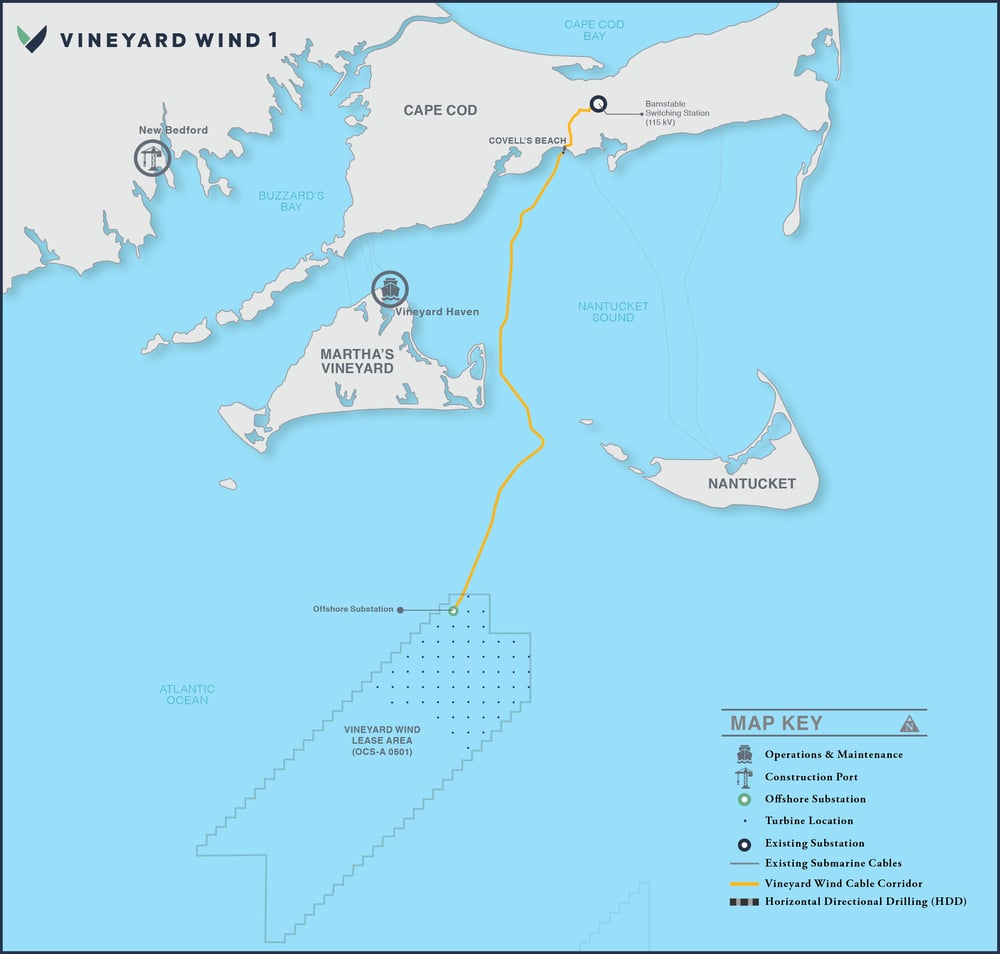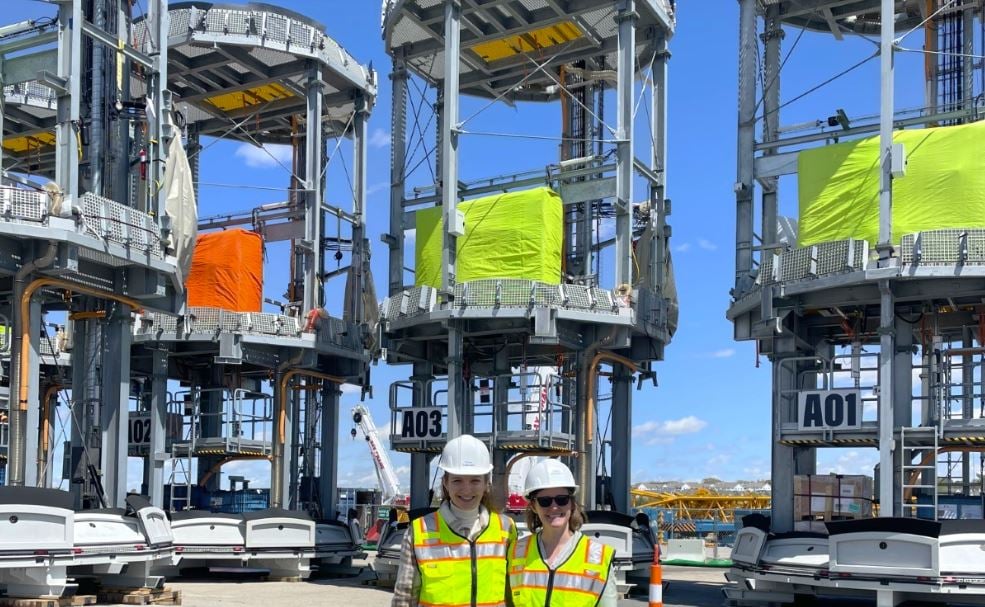Poll Finds Majority Support for Offshore Wind in Southern New England
If you read our blog on the High Cost of Saying NO to Offshore Wind, you know that offshore wind technology brings...
There has been a lot of news about offshore wind in New England lately. First, some good news: Vineyard Wind 1, an 800MW project contracted with Massachusetts, is currently under construction and expected to be up and running by the end of the year. The project is expected to produce enough power for more than 400,000 homes and create approximately 3,600 Full Time Equivalent (FTE) job years. In Rhode Island news, The Bureau of Ocean Energy Management (BOEM) issued the Final Environmental Impact Statement (FEIS) for Revolution Wind 1, a 704MW project with 400MW contracted with RI and 304MW contracted with CT. This FEIS is the second to last step before final approval, which is expected by the end of the summer.

Vineyard Wind 1 is located 15 miles south of Martha's Vineyard and Nantucket. The location was determined through a multi-year, intergovernmental task force process, which carefully considered scientific data and public input. This area boasts powerful, reliable wind speeds and ideal site conditions to support wind turbines.
Additionally, South Fork Wind, a 132 MW project located 35 miles east of Montauk Point is also under construction and expected to be up and running later this year. This project is New York’s first offshore wind farm and will address East Hampton’s energy needs, producing enough clean energy to power 70,000 homes. The project just installed the first US-built offshore substation and is being supported by 3 Northeast ports, one of which being ProvPort in Rhode Island.

Pictured above is myself and Susannah Hatch, the director of the New England for Offshore Wind Coalition, on a tour of Orsted’s ProvPort facility. Behind us are the advanced foundation components for the South Fork wind project, which speaks to how RI serves as a regional hub for offshore wind; benefitting from good union jobs that boost our local economy!
While these projects are moving forward, projects a little later in the development pipeline have been hit with an abruptly changing economy. A combination of inflation, Putin’s invasion of Ukraine, and supply chain shortages have caused problems for fixed-priced contracts established prior to these abrupt economic changes. Commonwealth Wind 1, a 1,200MW project being developed by Avangrid, and SouthCoast Wind, a 1,200 MW project, have both canceled or are in the process of canceling their contracts with Massachusetts. In Rhode Island, a similar scene is playing out where the sole proposal in response to Rhode Island Energy’s RFP, an 884MW joint proposal from Eversource & Orsted, was rejected by the utility, Rhode Island Energy, due to price concerns.
Rhode Island Energy will now have to justify its decision with the Public Utilities Commission, which we will be following closely. It’s certainly possible that Rhode Island Energy made the right call on the bid, but the decision to reject the bid should not be made by an investor-owned utility. There is too much long-term public interest at stake. We call on the Rhode Island Public Utilities Commission, Governor McKee, and Attorney General Neronha to carefully review the matter and to learn as much as possible so that the state is better prepared for the next move, one that we need to take sooner rather than later.
While the contract cancellations in Massachusetts and the proposal rejection in Rhode Island are very disappointing, geopolitical events impacting inflation and supply chain issues have had negative impacts economy-wide across the world, not just on the offshore wind industry and not just in the US. It is important to remember that electricity prices rose sharply this past winter due to fossil fuel price volatility. Offshore wind holds great promise to help both RI and MA not only achieve their Greenhouse Gas emissions reduction mandates of net zero by 2050, but also to create good-paying union jobs, enhance the local economy, and free us from fossil fuel price volatility.
Reminder: The United States is behind on offshore wind.
As of 2022, more than 50 Gigawatts (GW) of offshore wind (50,000 Megawatts) have been installed globally, enough to power more than 18 million U.S. households. The Biden Administration has set a goal to achieve 30 GW of offshore wind energy capacity by 2030. We must follow the successes of other countries and achieve this target.
We, along with the New England for Offshore Wind Coalition, strongly support ensuring fair energy prices for ratepayers, and we now call on New England states to collaborate on a joint procurement initiative. We believe a unified demand for offshore wind energy will allow states to pool their resources, attract increased private sector investments, and encourage developers to scale up their projects thereby benefitting from economies of scale that can lower overall costs. Offshore wind holds tremendous promise as a clean, reliable, and scalable source of energy to combat the climate crisis. We must continue to move forward while learning from Rhode Island’s and other states’ experiences, and a joint procurement approach does just that.
In 2022 Governor Baker signed an Act Driving Clean Energy and Offshore Wind into law, which codifies a goal of Massachusetts's procuring 5,600MW of offshore wind by 2027. As a first step to achieving that goal, the MA Department of Energy Resources (DOER) has submitted a draft solicitation for 3,600 MW to the Department of Public Utilities for review. This solicitation would meet more than 25% of MA’s annual electricity demand. The proposed timetable for the solicitation is that bids will be due January 31, 2024, the selection of projects by DOER would be due by June 12, 2024, with the final submittal of contracts to the DPU due by September 18, 2024. This long lead time allows for developers to incorporate emerging initiatives such as federal program guidance on tax credits and federal grants for transmission upgrades, as well as time for coordination with regional state partners on a potential joint procurement. The state of Connecticut also just released a draft RFP and Rhode Island very well may be next, given the status of its most recent RFP. Additionally, Maine just passed a major offshore wind bill to procure at least 3,000MW by 2040. We encourage these states to work together to reach a solution that will result in bringing offshore wind online, at a large scale, and at a fair price to ratepayers.
Several analyses have shown that offshore wind will be the linchpin of Rhode Island's and Massachusett's decarbonization strategies. Both states need to bring online a lot more offshore wind and clean energy resources to help electrify transportation and heating and transition away from fossil fuels. Collaboration among New England states to collectively harness the vast potential of offshore wind energy can pave the way for continued offshore wind development, and ensure we stay on the path towards achieving our climate goals.
For more about our view on the situation in Rhode Island, our executive director is quoted in this article from the Providence Business News.
If you read our blog on the High Cost of Saying NO to Offshore Wind, you know that offshore wind technology brings...
The climate crisis demands a fundamental cultural shift in our energy system. Revolution Wind 1 and the South Fork...
Comments